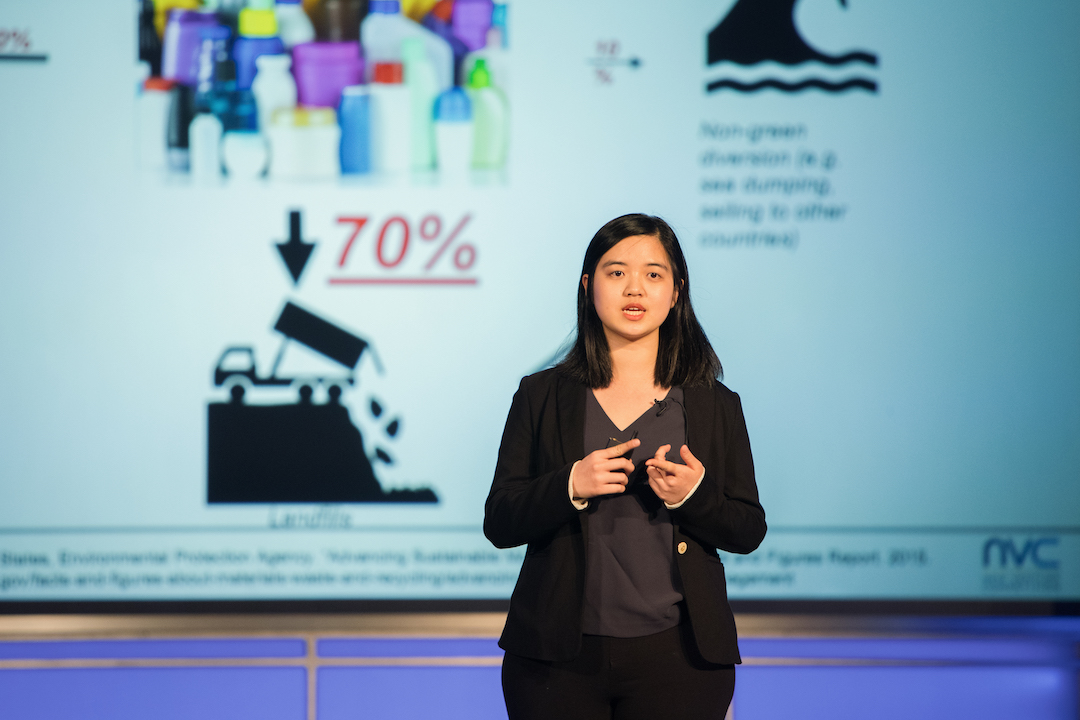By Nick Erickson
Before he moved to the United States a teenager, George Washington University alumnus Khang Vuong, M.H.A. ’17, envisioned the glamour and power of Wall Street in New York as a microcosm of the rest of the country.
When he actually arrived, he discovered that was far from the case.
Vuong lived in a small town just outside Atlanta before going to undergraduate school in rural Tennessee. He came to realize that middle class and lower income individuals and families accounted for a large portion of the U.S. population, and that was only intensified as a grad student at GW’s Milken Institute School of Public Health when he led a research project studying access—or lack thereof—to healthcare in Southeast Washington, D.C.
“It was very formative of me getting to understand what the real American is like,” Vuong said of his upbringing.
He was and remains startled by the number of people in a supposed world superpower either medically uninsured or underinsured. Despite consistently ranking as the world’s top GDP, the United States’ percentage of total population covered by medical care is way down the list compared to developed nations, many of which have 100% government funded insurance.
Currently, there are just over 26 million people in the United States who are uninsured, which is roughly 8.5 percent of the population. Vuong, who spent years without healthcare coverage himself, believes this sector of the U.S. population goes wildly unnoticed, and even if it is recognized, there’s no urgency to correct it. As he put it, it’s “hard to disrupt a system that generates so much capital from the 90% who have insurance to include those who don’t."
And, as he’s noted through his own lived experiences and research in both rural and urban America, this issue blurs political divide.
“That’s really eye opening for me because those two groups of people are probably politically opposite, but they share the same problem,” Vuong said. “It’s an American problem.”
While studying public health administration at GW, he turned to entrepreneurialism to disrupt this problem, and the Office of Innovation and Entrepreneurship gave him the confidence to start his own company. Utilizing resources such as the Mentors-In-Residence program, I-Corps and the New Venture Competition, Vuong launched an online platform that eventually turned into his now multi-million-dollar company, Mira, a membership model that allows individuals who can’t afford insurance to access essential services such as urgent care, lab tests, primary care, mental health counseling and even prescription discounts.
At an average of $45 a month, which Vuong estimates is about 10 times less than an average healthcare plan’s monthly payment, the platform caters to users who are young, without insurance or underinsured without much knowledge of the healthcare system. Members pay that fixed fee, and then Mira works with providers to get them the best rates. When members need care, they can find, book and pay using Mira’s platform. As the website indicates, it’s like Costco but for healthcare.
Mira users pay a fixed fee to be matched with providers who can provide more affordable healthcare options than paying out of pocket, as shown on the table above.
For comparison, routine bloodwork out of pocket costs a little over $300. When Mira pays the copay, that same bloodwork is just $49. With Mira, medications can be up to 80% off compared to full price out of pocket.
“We want Mira to be the first line of defense for those who need healthcare,” Vuong said.
It is also open to freelancers and contractors who might not have access to employer-based insurance.
“It’s how healthcare access should look for millennials,” added GW Associate Professor of Health Policy Lorens Helmchen, who worked with Vuong through I-Corps.
The Mira network, officially launched 2019, has expanded to over 2,000 clinics, 1,600 lab sites and 60,000 pharmacies, and the company has secured $2.8 million in funding. Its societal impact landed Vuong on the Forbes 30 Under 30 list for healthcare.
Even during Mira’s infant stages in the labs and classrooms at GW, Helmchen could see Vuong’s energy and passion in addressing inadequate access to healthcare in the United States.
“You felt a certain drive, an eagerness and a healthy dose of impatience that I think founders need,” Helmchen said. “You need to be impatient with how things are going and channel that frustration to a focus and a drive to make a change.”
While Vuong acknowledges how crippling the pandemic was both from health and economic perspectives, he noted that it at least exposed the healthcare system’s fragility. And from a pure business perspective, Mira ended up with 5 million unique visitors in 2020. At one point, it had 600 visitors per minute, which is more traffic than a TSA line at JFK Airport in New York. The platform pointed people to where they could get free COVID tests.
Vuong and his team have poured their effort into this product that has helped millions of people navigate the healthcare system, but he wishes he could turn his focus to something other than fighting for what he believes is a basic need. As he put it, Mira exists because of a systemic flaw.
“What would happen, though if companies like Mira didn’t exist?” he said. “With the cost of inflation, more people will have to choose between paying their mortgage or paying for a medical bill. And I always think about going back to my upbringing, right. I always think about those people in rural Tennessee and those in Southeast D.C. Where are they going to go?”
Vuong is not going anywhere. He is going to continue networking, learning and refining to shake up healthcare’s status quo so all Americans—no matter their race, income level or place of residence—can have access to what he considers a human right.
“We need more people like Khang,” Helmchen said. “We need more disruptors and more people who are willing to try something and try it enthusiastically.”





